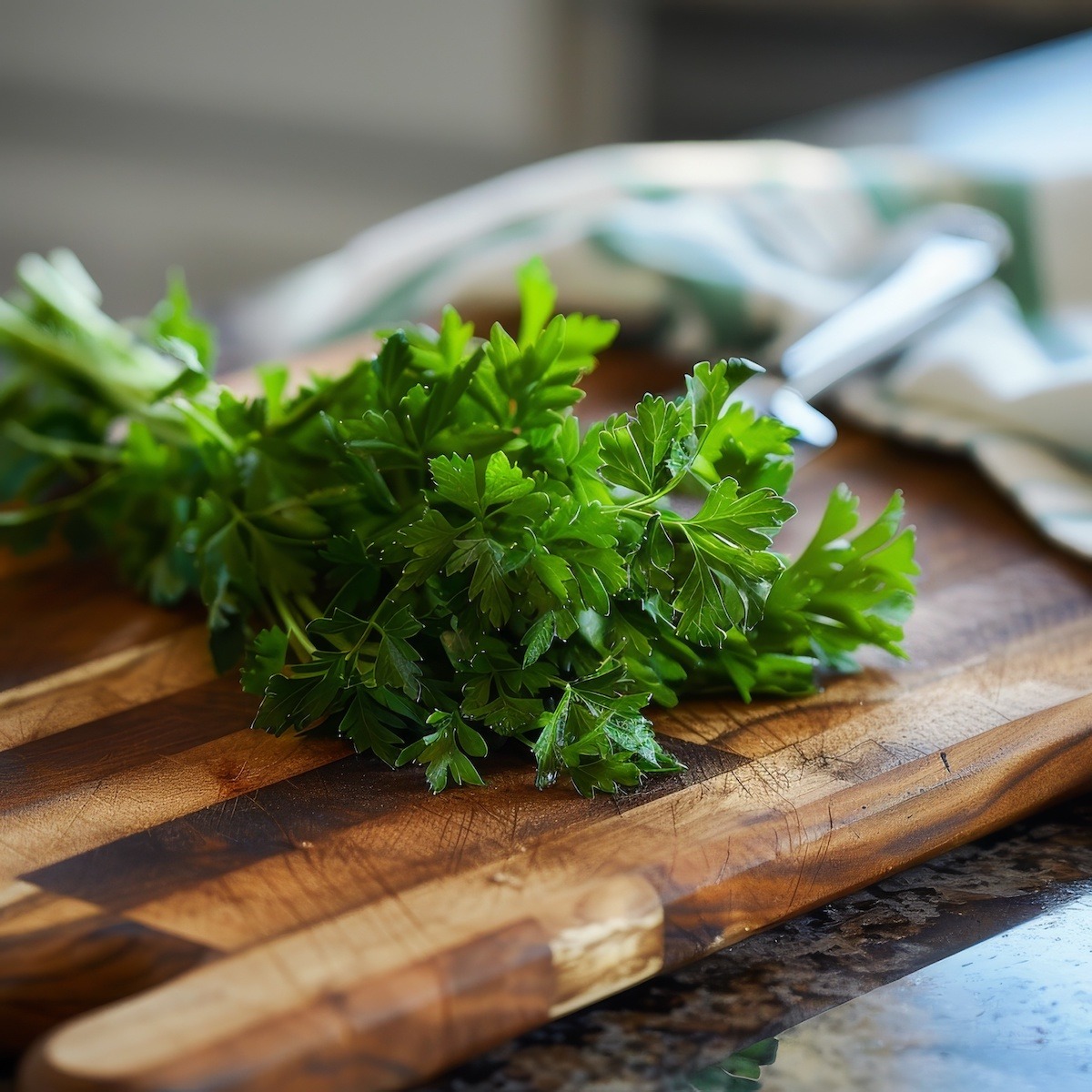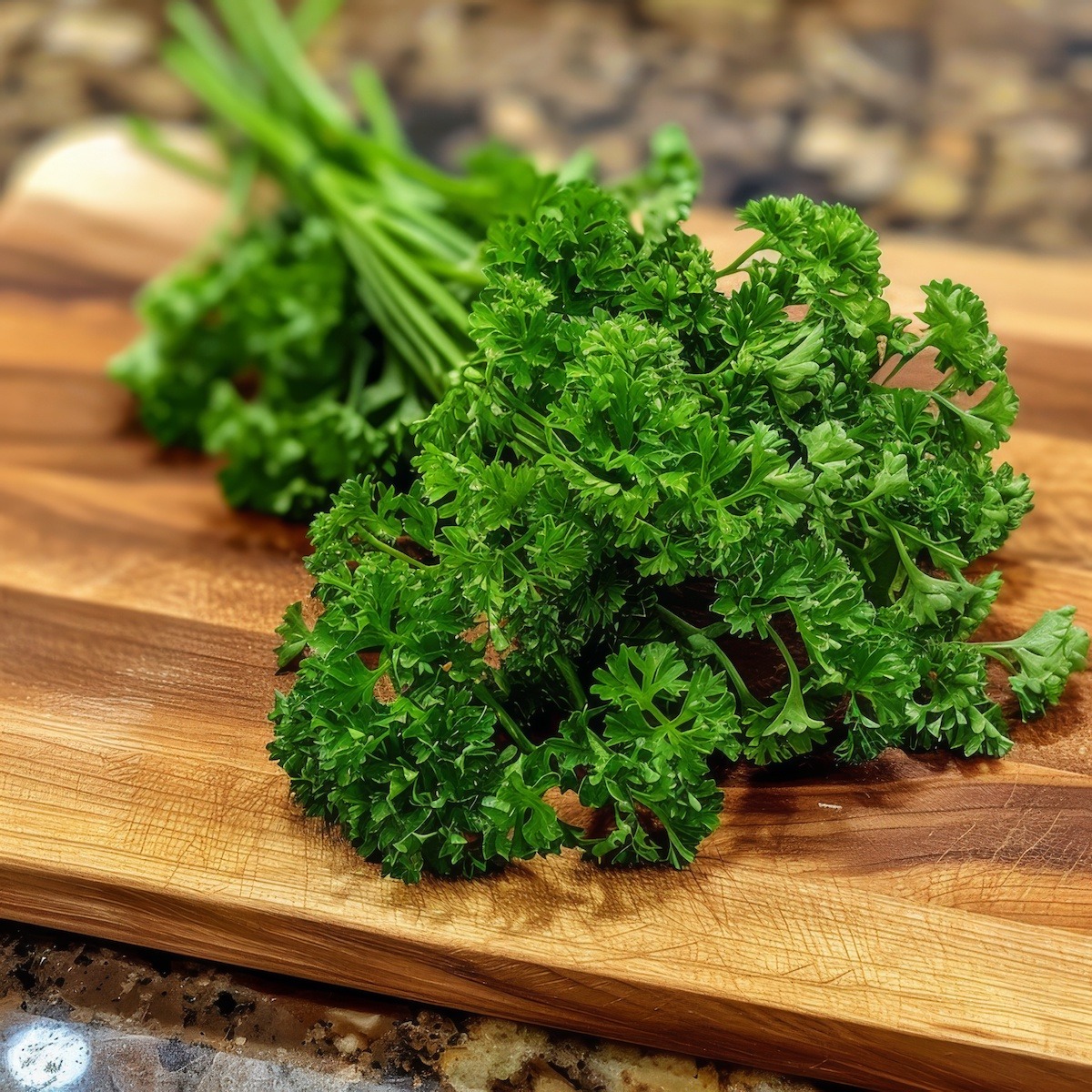

All About Parsley
As a kid, I was allergic to parsley. At least, that’s what I told my mother. I’m unsure if I was allergic or just made that up. Today, I’m a huge fan and enjoy it as a seasoning or garnish on many of my meals.
Parsley, with its vibrant green leaves and fresh, crisp flavor, is not just a garnish but a culinary powerhouse that has been prized for centuries. Belonging to the Apiaceae family, parsley (Petroselinum crispum) is a versatile herb used in cuisines worldwide, adding depth and brightness to dishes.
There are two main parsley types: curly and flat-leaf (Italian). Curly parsley is often used as a garnish for its decorative appearance, while flat-leaf parsley is favored for its stronger flavor and is commonly used in cooking. Both varieties boast an earthy, slightly peppery taste that can enhance a wide range of dishes.
One of the most appealing aspects of parsley is its nutritional value. It is rich in vitamins A, C, and K, iron, and folate. Additionally, parsley contains antioxidants such as flavonoids and volatile oils, which may have various health benefits, including reducing inflammation and supporting heart health.
Parsley is incredibly versatile in the kitchen. It can be used fresh or dried, and its flavor pairs well with numerous ingredients. From soups and salads to sauces and marinades, parsley adds a fresh and herbaceous element to dishes. In Mediterranean cuisine, it is a staple ingredient in tabbouleh, a refreshing salad made with parsley, bulgur wheat, tomatoes, and other herbs. In Italian cuisine, flat-leaf parsley is a key component of salsa verde, a zesty green sauce typically served with grilled meats or fish.
Beyond its culinary uses, parsley has also been valued for its medicinal properties throughout history. Traditional medicine has been used to aid digestion, freshen breath, and even alleviate symptoms of certain ailments. While modern science continues exploring its potential health benefits, parsley remains a beloved herb that is appreciated for its flavor and potential contributions to well-being.
Whether adding a finishing touch to a dish or taking center stage in a recipe, parsley’s bright flavor and nutritional profile make it a must-have in any kitchen. Its versatility and health benefits ensure that it will continue to be cherished by cooks and food enthusiasts for generations to come.
Flat Leaf and Curly Parsley

Curly parsley and flat-leaf parsley, also known as Italian parsley, are two distinct varieties of the same herb, Petroselinum crispum. While they share similarities in flavor and culinary uses, there are some notable differences between the two:
Appearance: As the name suggests, curly parsley has tightly curled leaves that resemble miniature rosettes. Due to their decorative appearance, its vibrant green leaves are often used as a garnish.
Flat-leaf parsley has broader, flat leaves with a smoother texture. Its leaves grow in clusters and are a darker shade of green than curly parsley.
Flavor: Curly parsley tends to have a milder flavor than flat-leaf parsley. Its taste is fresh and slightly grassy, with subtle hints of bitterness. Flat-leaf parsley has a stronger, more robust flavor profile than curly parsley. It is often described as having a peppery or slightly tangy taste with earthy undertones.
Culinary Uses: Curly parsley is commonly used as a garnish to add color and texture to dishes. It is frequently sprinkled over finished plates or used to decorate platters. Flat-leaf parsley is preferred for cooking due to its stronger flavor and more substantial leaves. It is used as a flavoring agent in soups, stews, sauces, marinades, and salads. It is also popular in Mediterranean and Italian cuisines, where it is used in dishes like tabbouleh, salsa verde, and gremolata.
Availability: Curly parsley is commonly found in supermarkets and grocery stores, often sold alongside other fresh herbs in bunches. Flat-leaf parsley is also widely available but may be more prevalent in specialty markets or ethnic grocery stores, particularly those catering to Mediterranean or Italian cuisine.
History
Parsley (Petroselinum crispum) has a rich history that spans thousands of years and is intertwined with various cultures and traditions worldwide.
- Ancient Roots: Parsley is believed to have originated in the Mediterranean region, with its cultivation dating back to ancient times. It was revered by civilizations such as the ancient Greeks, Romans, and Egyptians, who used it not only as a culinary herb but also for its medicinal properties and as a symbol of celebration and remembrance.
- Symbolism and Folklore: In Greek mythology, parsley was associated with the god of the underworld, Persephone, and was often used to adorn tombs and symbolize death and rebirth. In ancient Greece, athletes were crowned with parsley during the Olympic Games as a sign of victory and achievement. Similarly, in Roman culture, parsley was used to decorate banquet tables and was believed to ward off intoxication.
- Medicinal Uses: It has been valued throughout history for its medicinal properties. Ancient civilizations used it to aid digestion, freshen breath, and treat ailments such as arthritis and kidney stones. In medieval Europe, parsley was considered a potent diuretic and was used to treat urinary tract infections and other urinary disorders.
- Culinary Importance: It has been a staple herb in Mediterranean, Middle Eastern, and European cuisines for centuries. It is commonly used fresh as a garnish and as a flavoring agent in soups, stews, sauces, and salads. In Italian cuisine, flat-leaf parsley is a key ingredient in dishes like salsa verde and gremolata, while curly parsley is often used for decorative purposes.
- Modern Cultivation: Today, it is cultivated worldwide and is readily available in fresh and dried forms. It continues to be a popular herb in both home kitchens and professional culinary settings, prized for its fresh flavor, versatility, and nutritional benefits.
Why Do I See It In So Many Recipes?
Parsley’s ubiquity in recipes across various cuisines stems from its versatility, flavor profile, and nutritional benefits. Here are a few reasons why parsley frequently appears in recipes:
- Freshness and Vibrancy: Parsley’s vibrant green color and fresh flavor add visual appeal and brightness to dishes. Whether sprinkled over a finished dish or incorporated into a recipe, it can elevate the overall presentation and make the dish more appetizing.
- Balanced Flavor: Parsley has a balanced flavor profile complements various ingredients and dishes. Its slightly peppery and herbaceous taste adds depth without overpowering other flavors, making it a versatile herb that can be used in various cuisines and dishes.
- Enhanced Taste and Aroma: Parsley can enhance the taste and aroma of dishes. Its fresh and aromatic qualities can help round out flavors and create a more well-rounded culinary experience.
- Nutritional Benefits: Parsley is not just a garnish; it’s also packed with nutrients. It is rich in vitamins A, C, and K, iron, and folate. Additionally, it contains antioxidants and other beneficial compounds that may contribute to overall health and well-being. Including parsley in recipes is a simple way to boost the nutritional content of dishes.
- Culinary Versatility: Parsley can be used in various forms, including fresh, dried, or as part of a seasoning blend. It can be added to salads, soups, stews, sauces, marinades, and more, making it a versatile ingredient that can be incorporated into various recipes.
Some of My Favorite Ingredients
 Print
Print




